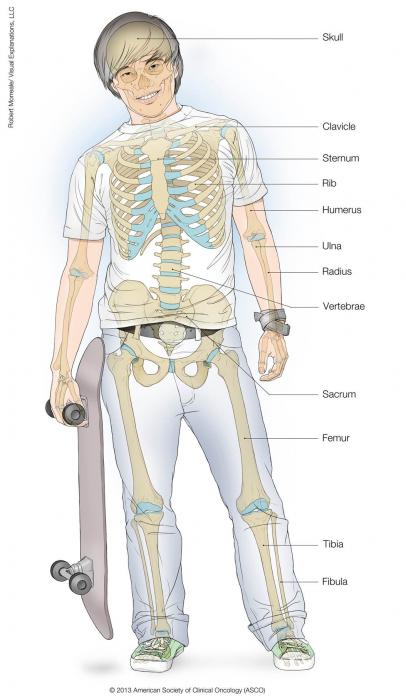ON THIS PAGE: You will find some basic information about this disease and the parts of the body it may affect. This is the first page of Cancer.Net’s Guide to Osteosarcoma in Childhood and Adolescence. Use the menu to see other pages. Think of that menu as a roadmap for this entire guide.
About sarcoma
Sarcoma is cancer that develops in the tissues that support and connect parts of the body. These include bone, fat, muscle, and soft tissue. Cancer begins when healthy cells change and grow out of control, forming a mass called a tumor. A tumor can be cancerous or benign. A cancerous tumor is malignant. This means that it can spread to other parts of the body, called metastasis. A benign tumor means the tumor is unlikely to spread.
About osteosarcoma

Osteosarcoma is a cancer of the bone that destroys tissue and weakens the bone. It develops from immature bone cells that normally form new bone tissue.
Osteosarcoma most often starts in a leg bone around the knee joint, either at the femur, which is the lower end of the thigh bone, or the tibia, which is the upper end of the shin bone. The next most common place osteosarcoma begins is in the humerus. This is the upper arm bone close to the shoulder.
However, osteosarcoma can develop in any bone in the body. Rarely, it occurs as a tumor in the body’s soft tissue, outside the bone.
Types and subtypes of osteosarcoma
There are 2 types of osteosarcoma:
-
Central tumor, also called a medullary tumor
-
Surface tumor, also called a peripheral tumor
Each type of osteosarcoma has different subtypes. The type and subtype of osteosarcoma is determined by looking at the tumor cells through a microscope.
Subtypes of central/medullary osteosarcoma include:
-
Conventional central osteosarcoma, such as osteoblastic, chondroblastic, fibroblastic, and mixed types
-
Telangiectatic osteosarcoma
-
Intraosseous well-differentiated or low-grade central osteosarcoma
-
Small cell osteosarcoma
Subtypes of surface/peripheral osteosarcoma include:
-
Parosteal well-differentiated or low-grade osteosarcoma, also called juxtacortical osteosarcoma
-
Periosteal osteosarcoma that is low grade to intermediate grade
-
High-grade surface osteosarcoma
The most common subtype of osteosarcoma is conventional central osteosarcoma. The other subtypes are much less common. They each account for less than 5% of all osteosarcomas.
The tumor's grade is the most important factor in treatment decision-making. This is because low-grade tumors only recur in the same area, called locally. High-grade tumors metastasize, or spread, to other parts of the body and can recur anywhere in the body. Most osteosarcoma in children are high grade.
This guide covers osteosarcoma that is diagnosed during childhood and adolescence, also called pediatric osteosarcoma. Visit the bone cancer and soft tissue sarcoma guides of this website to learn more about other types of sarcoma.
Looking for More of an Introduction?
If you would like more of an introduction, explore these related items. Please note that these links take you to other sections on Cancer.Net:
-
Cancer.Net En Español: Read about osteosarcoma in Spanish. Infórmase sobre osteosarcoma en la infancia y la adolescencia en español.
-
Find a Cancer Doctor. Search for a cancer specialist in your local area using this free database of doctors from the American Society of Clinical Oncology (ASCO).
-
Cancer Terms. Learn what medical phrases and terms used in cancer care and treatment mean.
The next section in this guide is Statistics. It helps explain the number of people who are diagnosed with osteosarcoma and general survival rates. Use the menu to choose a different section to read in this guide.
